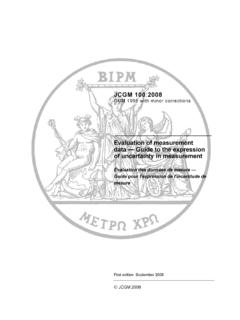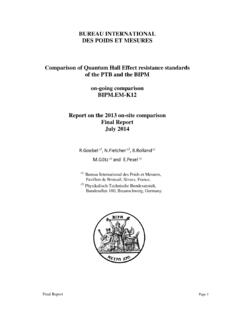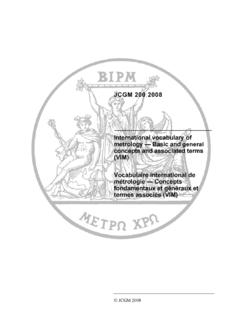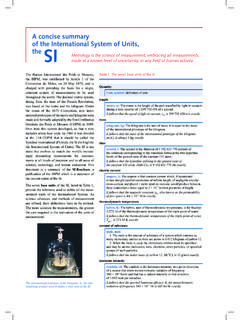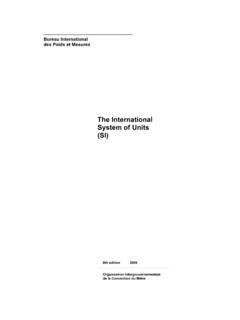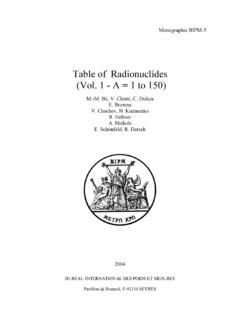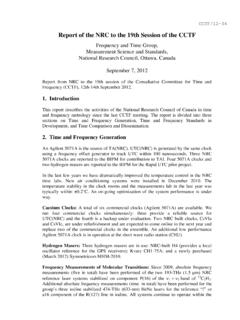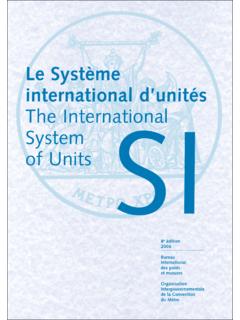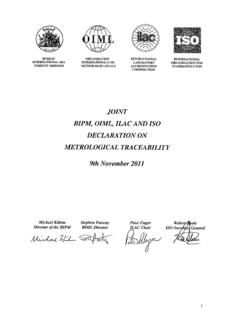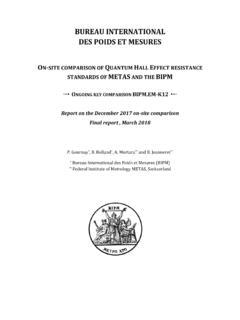Transcription of Calibration and Measurement Capabilities in the …
1 Version 5 March 2017 Calibration and Measurement Capabilities in the context of the CIPM MRA CIPM MRA-D-04 Version 5 Calibration and Measurement Capabilities in the context of the CIPM MRA CIPM MRA-D-04 Version 5 March 2017 Contents 1. Definition of Calibration and Measurement Capability (CMC) .. 1 2. Drawing up CMCs files .. 5 General instructions, format of the CMCs file.. 5 Specifying the scope of CMCs .. 12 3. Criteria for acceptance of CMCs .. 14 Requirements for traceability .. 14 Special criteria for 15 4. Intra-regional review of CMCs.
2 18 5. Inter-regional review of CMCs.. 18 Overview .. 18 Submission of CMCs .. 19 Steps followed in the inter regional 20 6. Publication of CMCs .. 21 7. BIPM interventions on CMCs.. 22 8. CMC inter regional review through the CC Working Groups on CMCs .. 23 9. Fast track approval of CMCs .. 24 10. Modification of existing CMCs .. 24 11. Monitoring process of published CMCs .. 26 12. Greying-out of published CMCs .. 27 13. Related documents .. 30 14. Revision History .. 31 Appendix 1 Flowchart of the CMCs review process .. 32 Appendix 2 Examples of CMCs 34 Appendix 3 Examples of CMCs tables with frequent mistakes.
3 37 Calibration and Measurement Capabilities in the context of the CIPM MRA CIPM MRA-D-04 Version 5 March 2017 Page 1 of 42 Back to table of contents 1. Definition of Calibration and Measurement Capability (CMC) In the context of the CIPM MRA and ILAC Arrangement, and in relation to the CIPM-ILAC Common Statement, the following shared definition was agreed upon: A CMC is a Calibration and Measurement capability available to customers under normal conditions: (a) as published in the BIPM key comparison database (KCDB) of the CIPM MRA; or (b) as described in the laboratory s scope of accreditation granted by a signatory to the ILAC Arrangement.
4 " Where the term NMI is used it is intended to include Designated Institutes (DIs) within the framework of the CIPM MRA. NOTES N1. The meanings of the terms Calibration and Measurement Capability, CMC, (as used in the CIPM MRA), and Best Measurement Capability, BMC, (as used historically in connection with the uncertainties stated in the scope of an accredited laboratory) are identical. The terms BMC and CMC should be interpreted similarly and consistently in the current areas of application. N2. Under a CMC, the Measurement or Calibration should be: - performed according to a documented procedure and have an established uncertainty budget under the management system of the NMI or the accredited laboratory; - performed on a regular basis (including on demand or scheduled for convenience at specific times in the year); and - available to all clients.
5 N3. The ability of some NMIs to offer special calibrations, with exceptionally low uncertainties which are not under normal conditions, and which are usually offered only to a small sub-set of the Calibration and Measurement Capabilities in the context of the CIPM MRA CIPM MRA-D-04 Version 5 March 2017 Page 2 of 42 NMI's clients for research or for reasons of national policy, is acknowledged. These calibrations are, however, not within the CIPM MRA, cannot bear the equivalence statement drawn up by the JCRB, and cannot bear the logo of the CIPM MRA.
6 They should not be offered to clients who then use them to provide a commercial, routinely available service. Those NMIs which can offer services with a smaller uncertainty than stated in the database of Calibration and Measurement Capabilities in the KCDB of the CIPM MRA, are, however, encouraged to submit them for CMC review in order to make them available on a routine basis where practical. N4. Normally there are four ways in which a complete statement of uncertainty may be expressed (range, equation, fixed value and a matrix).
7 Uncertainties should always comply with the Guide to the Expression of Uncertainty in Measurement (GUM) and should include the components listed in the relevant key comparison protocols of the CIPM Consultative Committees. These can be found in the reports of comparisons published in the CIPM MRA KCDB as a key or supplementary comparison. N5. Contributions to the uncertainty stated on the Calibration certificate and which are caused by the client s device before or after its Calibration or Measurement at a laboratory or NMI, and which would include transport uncertainties, should normally be excluded from the uncertainty statement.
8 Contributions to the uncertainty stated on the Calibration certificate include the measured performance of the device under test during its Calibration at the NMI or accredited laboratory. CMC uncertainty statements anticipate this situation by incorporating agreed-upon values for the best existing devices. This includes the case in which one NMI provides traceability to the SI for another NMI, often using a device which is not commercially available. N5a. Where NMIs disseminate their CMCs to customers through services such as calibrations or reference value provision, the uncertainty statement provided by the NMI should generally include factors related to the Measurement procedure as it will be carried out on a sample, , typical Calibration and Measurement Capabilities in the context of the CIPM MRA CIPM MRA-D-04 Version 5 March 2017 Page 3 of 42 matrix effects, interferences etc.
9 Must be considered. Such uncertainty statements will not generally include contributions arising from the stability or inhomogeneity of the material. However, the NMI may be requested to evaluate these effects, in which case an appropriate uncertainty should be stated on the Measurement certificate. As the uncertainty associated with the stated CMC cannot anticipate these effects, the CMC uncertainty should be based on an analysis of the inherent performance of the method for typical stable and homogeneous samples.
10 N5b. Where NMIs disseminate their CMCs to customers through the provision of certified reference materials (CRMs) the uncertainty statement accompanying the CRM, and as claimed in the CMC, must indicate the influence of the material (notably the effect of instability, inhomogeneity and sample size) on the Measurement uncertainty for each certified property value. The CRM certificate should also give guidance on the intended application and limitations of use of the material. N6. The NMI CMCs which are published in the KCDB provide a unique, peer reviewed traceability route to the SI or, where this is not possible, to agreed - upon stated references or appropriate higher order standards.
